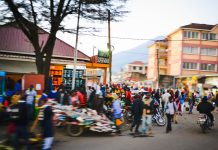In time for the 70th anniversary of Nigerian independence in 2030, Lagosians are celebrating a traffic-free Lagos Island. The Lagos government began working with residents and businesses on Lagos Island to systematically remove traffic early in the 2020s, following the city’s first Car Free Day in 2020. The results have made the economic hub of West Africa and mega-city of 40 million a genuinely pleasant place to live. Choking traffic was replaced with a world-class subway and electric trolley bus system. In just a decade, the city has become a model for other mega cities and their smaller peers to follow.
For Jakarta and Manila, and Miami, Lagos has become a model for more climate secure zero emissions urban transport and land use planning. Permanent traffic jams and honking horns on the Carter Bridge, the Eko Bridge and the Third Mainland Bridge have been replaced with the quiet of an all-electric public transport fleet and the sound of the city’s rivers and canals. Visitors from London and New York would visit through the 2020s to learn how their cities could learn from Lagos’s leadership on systematic traffic removal.
Free from motor vehicle traffic, residents of Oniru cycle and walk to work in Ajose Adeogun and other areas of Victoria Island along dedicated bicycle paths and widened pedestrian boulevards planted with a stunning array of local flowers and food crops. The subway system moves millions of passengers a day – more than any other city in the world – quietly under their feet. The only remaining road space dedicated to vehicle traffic is reserved for electric commercial delivery vehicles. The vast majority of commercial deliveries are done with e-tricycles or electric cargo boats manufactured on the mainland.
Lagosians and visitors to the metropolis walk to Oniru beach without having to worry about cars and other vehicles along Ligali Ayorinde leading up to the entrance of the beach. With a modest reallocation of space away from private cars to people walking and cycling, the city was transformed into a healthier, safer, and more prosperous place. Once private cars were officially removed from Lagos Island in 2022, residents and visitors to the city couldn’t imagine going back to the dangerous, polluted and stressful status quo of Lagos traffic jams.
The backbone of traffic-free Lagos is the new public transport system, with a newmetro line that runs from Ojota on Ikorodu Road all the way to Ahmadu Bello Way. Another metro line runs from Murtala Mohammed Airport with major stops along the Oshodi-Apapa expressway and connects to the metro line from Ojota to Ahmadu Bello Way on Victoria Island.
Beginning in the early 2020s, Force Road in Onikan leading up to Tafawa Balewa Square was transformed into a play zone for children and adults. Lagos’ architects and urban designers had been inspired by Oslo’s pedestrianised town centre and playstreet for children and adults. Tafawa Balewa Square was the first of many land conversions from parking space and roads to new public parks, playgrounds and affordable housing that gathered pace through the decade.
Alongside the systematic removal of cars from the city centre, the other major project for the 2020s was opening up the canal systems running across Lagos Island, Victoria Island and the into the mainland. Teams of youth were employed to clear and clean the canals and to manage the reintroduction of local wildlife and fish stocks. Lagos State-operated electric ferries move people around quietly and quickly across the mega-city. Residents and visitors entering Victoria Island get there via waterways that stretch as far as Ikorodu, Badagry and Epe. Coming from Lekki takes just a few minutes on a new metro line connecting Victoria Island to the rest of the sprawling metropolis. Lagos in 2030 is an exceptional city.






































